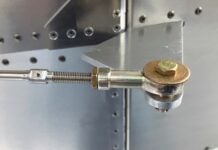If you are building an aircraft kit that uses aluminum for its skin, there is little doubt that you will have to handle rather large, thin sheets during the life of the build. These sheets may form the surface of the wings, fuselage, or tail structures, depending on the particular design. This means those sheets can be as long as ten feet and several feet wide. Handling these as a lone builder can be dangerous to you as well as the integrity of the sheet. An unwanted kink or dimple is surprisingly easy to form when moving the sheet into position and will ruin your day and wallet in no time. Don’t ask how I know!
Usually the sheets are shipped from the kit manufacturer in a completely flat position, possibly on a pallet, separated by cardboard or paper wrapping. It is always highly recommended to inspect the individual sheets upon delivery to your shop—and here begins the first handling operation of these unwieldy objects. (You will feel a little funny calling the kit manufacturer six months down the road about a damaged sheet if you choose not to inspect them now!) While it is always easier and safer to obtain a helper in lifting and separating the sheets for inspection, the next decision is how to store them until they are needed during the build. Lay them flat on the floor or up against the wall? Can you identify the left top wing skin from the fuselage bottom when they are flat on the floor in a stack?
One method I’ve used for storing large sheet metal pieces safely is to immediately roll them into a coil and fasten them with a clamp so they do not unwind. If you have predrilled skins, you can even use a Cleco through available holes to hold the ends in place. These rolls are easily handled by a single person without danger of kinks or bends. They are easily unrolled on the table after removing the clamp or Cleco. In addition, these rolls are easy to identify as they patiently wait their turn until you need them during construction. The roll makes it easy to examine their unique shapes and cutouts as you match them to your plans. The coil form also prevents damage during storage as they are hard to step on, and if you bump into them, they usually just wobble without a care. Coil your sheets and worry a little less!

![]()
As the founder of HomebuiltHELP.com, Jon Croke has produced instructional videos for Experimental aircraft builders for over 10 years. He has built (and helped others build) over a dozen kit aircraft of all makes and models. Jon is a private pilot and currently owns and flies a Zenith Cruzer.














